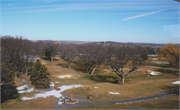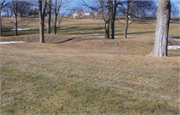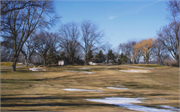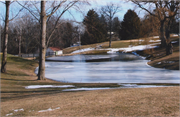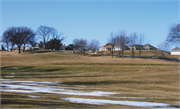Property Record
W270 S3425 MERRILL HILLS RD
Architecture and History Inventory
| Historic Name: | Waukesha Country Club/Golf Course |
|---|---|
| Other Name: | Merrill Hills Country Club/Golf Course |
| Contributing: | |
| Reference Number: | 220406 |
| Location (Address): | W270 S3425 MERRILL HILLS RD |
|---|---|
| County: | Waukesha |
| City: | |
| Township/Village: | Waukesha |
| Unincorporated Community: | |
| Town: | 6 |
| Range: | 19 |
| Direction: | E |
| Section: | 18 |
| Quarter Section: | NE |
| Quarter/Quarter Section: |
| Year Built: | 1930 |
|---|---|
| Additions: | |
| Survey Date: | 2011 |
| Historic Use: | country club |
| Architectural Style: | NA (unknown or not a building) |
| Structural System: | |
| Wall Material: | |
| Architect: | Charles H. Harwood; Leonard Macomber |
| Other Buildings On Site: | Y |
| Demolished?: | No |
| Demolished Date: |
| National/State Register Listing Name: | Not listed |
|---|---|
| National Register Listing Date: | |
| State Register Listing Date: |
| Additional Information: | A 'site file' exists for this property. It contains additional information such as correspondence, newspaper clippings, or historical information. It is a public record and may be viewed in person at the Wisconsin Historical Society, State Historic Preservation Office. In February 1929, a group of around twenty Waukesha residents met to discuss a private, eighteen-hole golf course and country club. Consisting primarily of area businessmen and professionals who belonged to a group known as the Waukesha Golf Club, many of these people either played golf on a nine-hole course at Waukesha’s Moor Mud Baths (which opened in 1915), Westmoor Country Club in the Town Brookfield or ventured to one of several courses in Milwaukee County to play. On 22 March 1929, two-hundred club members met to charter the Spring City Land & Investment Company, which was tasked to identify a site location. Club member and insurance adjuster Earle Hardy remembered an attractive parcel owned by Decatur Merrill in the Town of Waukesha. Hardy discovered the location a few years earlier during an insurance claim visit regarding a cow hit by lightning. Spring City then bought the parcel from Merrill for $22,000. The Waukesha Country Club incorporated on 3 April 1930. The president of the club was Hawley W. Wilbur and the chairman of the sites and grounds committee was Charles H. Harwood. Harwood consulted with Leonard Macomber of Chicago, who had designed several courses in Wisconsin, and hired Fred Peters as superintendent of construction. Peters later became the first groundskeeper and served in that position until 1944. It is believed that Harwood – an amateur engineer and landscaper -- came up with most of the course’s ultimate design. The course was laid out with the condition that the parcel’s rolling terrain would not be altered. Greens and fairways were graded in September 1929, while plans for a clubhouse were delayed due to financing. The barn (no longer extant) on the former Merrill farmstead located at the parcel’s northeast corner was used as the course’s maintenance building and the old farmhouse (no longer extant) became the house of the course superintendent. Besides the initial funding provided by subscribers ($250 each) to the Spring City company, the club was funded with annual dues and membership fees, as well as green fees paid ($1 for members and $1.50 for non-members). The club initially had five committees to run its affairs. Charles Harwood headed the grounds committee and Earle Hardy was in charge of the men’s golf committee. E. L. Eichelberger was in charge of entertainment; Mr. A.R. Morton led the women’s golf committee and L.F. House chaired the house committee. The course opened on 15 June 1930 when club president Marcus A. Jacobson hit the ceremonial first drive. Opening day festivities included an exhibition match that featured four of the state’s best golfers and the public was invited to bring their picnic baskets while they observed the match. The course consisted of four par-five, ten par-four and four par-three holes. An article in the Waukesha Freeman described the course’s most interesting holes with the eighth (currently the 17th) as the most attractive due to it being surrounded by mature trees with the green situated on top of a rise. Meanwhile, the par-five fourth (11th) hole was difficult due to its length while the 125-yard sixteenth (7th) required a well-placed shot to avoid a water hazard. The paper also highlighted that the course’s many “dangerous traps” along the fairways and around the greens required the golfer to execute well-placed shots “to shoot near par”. Located on the site of the current clubhouse, the course’s original clubhouse (no longer extant) was completed in 1931 and designed by Otis & Fuller of Chicago. It was seen by club leaders as a key attribute to the club’s financial success since it would increase interest in the organization. In addition to the club’s approximately 240 members, 8,000 guests utilized the club for golf or other social activities in 1931. During these early years, the club hosted the Wisconsin Open and the Wisconsin State Amateur tournaments. By 1934, the club’s social calendar had expanded significantly. Bi-weekly dinner parties and dances were well attended and the women’s committee expanded both golfing and social events. Also in 1934, the club changed its name to Merrill Hills Country Club to honor the Merrill family, as well as implement part of the club’s mortgage renegotiation agreement with Decatur Merrill. The renegotiation was needed to help the club survive the Great Depression. MHCC again in 1942 sponsored the Wisconsin State Amateur Tournament after which time, most of the original sand traps along the fairway were allowed to transition to grass; this condition continued throughout World War II. In the 1930s and 1940s, the course was notorious for rock-hard fairways that allowed a ball to roll for many yards after a shot. It was also during its early years infested with dandelions and gopher holes. In 1951, the club installed an irrigation system and course conditions improved significantly. In 1953, MHCC embarked on a major building program to modernized the club and expand its slate of activities in order to entice young families to join the organization. It added the present-day pro shop and golf pro house, as well as a swimming pool (since replaced). The clubhouse received a 200-person dining room addition by Ebling, Plunkett & Keymar and a kitchen upgrade. The $137,700 project required that annual membership fees be raised to $240, which did not include social or golf privileges. Membership remained in the 250-person range and a significant number of the club’s members belonged to Waukesha’s business and professional elite. The clubhouse, at the time, served lunch and it was a noted site where area businessmen entertained clients. MHCC also became an important part of the social calendar. It hosted a number of balls and formal events throughout the year, which were covered in the society section of the Waukesha Freeman. In 1972, MHCC hired golf course architect Edward Lawrence Packard to redesign aspects of the golf course. It was at this time that the order of holes was changed. Six years later, the original pool was replaced and four tennis courts were built. MHCC tore down the original clubhouse in the fall of 1988 and completed the present one by the spring of 1989. It installed in 1992 a dual irrigation system that watered the rough in addition to the fairways. The club obtained a parcel south of the course in 1997 and has since constructed a driving range. "Waukesha Bypass Architecture/History Survey--Addendum," WisDOT #2788-01-00 (January 2012), Prepared by Heritage Research. DOE prepared by Heritage Research (2012). |
|---|---|
| Bibliographic References: | "Merrill Hills Golf and Country Club Is Beauty Spot," Waukesha Freeman 75th Anniversary Edition, May 1934; Waukesha Country Club Opening Day Edition, Waukesha Freeman, 14 June 1930; Interview with long-time country club member. |
| Wisconsin Architecture and History Inventory, State Historic Preservation Office, Wisconsin Historical Society, Madison, Wisconsin |

